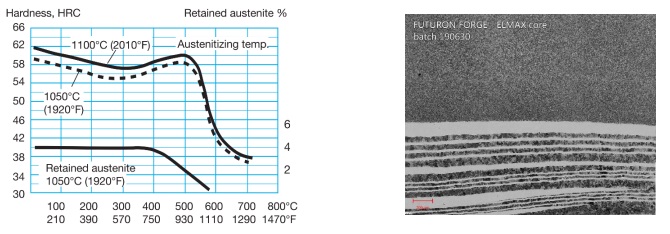Technical Information – FF ELMAX Core
Datasheet version: 03/2025
Composition
FF ELMAX Core is a san-mai layered stainless damascus made of a UHB Elmax central core and UHB AEB-L + AISI 304 jacket. Elmax Super Clean is a premium martensitic powder-metallurgical stainless steel with a fine grain structure, wear, and corrosion resistance, making it ideal for knife blades. It brings a durable edge and superior contrast with the side layers.

Machining conditions
Our products are soft annealed to achieve optimal machinability, with a hardness of approximately 280 HV. You can use all conventional machining methods. Avoid cutting or shaping the material with machine shears. We recommend using a bandsaw, milling, laser cutting, or waterjet cutting. For optimal core centricity, place the blade edge at the outer rim of the billet. The core thickness slightly increases from the center to the edges.
- Milling – monolithic carbide mill — Vc50-60 m/min
- For hard-milling (sizing) with monolithic carbide, mill feed up to Vc100 m/min
- Milling with VBD mill — Vc75-100 m/min
- Milling with HSS-Co mill — Vc14-16 m/min
- Drilling – HSS-Co drill — Vc10-12 m/min
- Drilling – PVD coated carbide drill —Vc60-80 m/min.

Grinding
You can grid our steel on all conventional types of grinders. We recommend belt-grinders or Berger grinding machines. For belt grinders, we recommend sanding belts with ceramic grains, like 3M Cubitron II; however, all ranges of conventional abrasives are usable (for example, SAIT, Klingspor, Norton, VSM, etc.). Avoid overheating (tempering) the steel while grinding. When heat-treated, it may lose the required properties.
Soft annealing /
Our materials are soft-annealed, and you don’t need to repeat this process. Annealing is only necessary if the material will be further reforged. In such cases, the steel structure and properties are not guaranteed. The procedure is as follows:
150°- Heat the material in a furnace to 820 °C / 1508
- Our materials are soft annealed. You have to apply this process only after forging.
- Protect the material before oxidation and heat in a furnace to 980°C / 1796°F
- Hold at the temperature for 2 hours at least
- Slow cooling in a furnace to 850°C / 1562°F (cooling 20°C / 68°F per hour)
- Hold at the temperature for 10 hours
- Slow cooling in a furnace until the temperature reaches 750°C / 1382°F
- Remove material from a furnace and keep slow cooling on the air.
Hardening
Hardening is essential to achieve full corrosion resistance and the final hardness of the steel. The steel has to be hardened by a professional company using vacuum technology like Bodycote. Recommended hardening process:
- Preheating temperature 600-850 °C / 1112-1562°F
- Austenitizing temperature 1050-1100 °C / 1922-2012°F.
- Hold at the temperature for 30 minutes
- Cooling by nitrogen gas (overpressure 2 bars) or by air up to the temperature 50 °C / 122°F
- Salt-bath hardening or discontinuously in oil is also possible
- Immediate deep freeze -150/-196 °C / -302/-384°F and hold for 1-3 hours. Hardness will increase by 1-3 HRc).
In case of a heat-treating failure, the material can be re-hardened only once. Multiple re-hardening cycles will cause material degradation.
Tempering
Tempering have to begin as soon as possible, no later than one hour after hardening.
- For knife blades, we recommend a tempering process 2x2h 200 °C / 392°F
- To keep blade flexibility, we recommend a minimal tempering temperature 180 °C / 356°F.

Etching
To properly contrast the damascus steel layers, etching the material (blade) is necessary.You can experiment with various etching techniques depending on your skill level. By following the steps below, you’ll achieve good results.
- Ensure that the blade’s surface is smooth, clean, and free of scratches (since etching won’t hide them), finished up to 1000+ grit or polished.
- Properly degrease the blade; cleaning it in the soap-water works well.
- Before etching, test the solution on a sample piece of heat-treated material.
- Before immersing the blade, check for surface dirt in the solution. The etched part has to be degreased and clean. Do not use automatic stirrers or shaking baths during etching. The etching solution can be reused multiple times.
- After etching, neutralize the blade using Na₂CO₃ (Sodium carbonate) or NaHCO₃ (Baking soda). You can also use soap water and properly clean the etching residues from a blade.
- Dry the etched blade. We recommend spraying the blade with WD-40 (or similar) and drying it again to remove any possible residues.
- You can slightly polish the etched blade on a buffing wheel for enhanced contrast. We recommend testing it on a sample piece.
- If you want to make your etching solution more reactive, increase the temperature, concentration of Fe3Cl, or add vinegar.

Marking
FF ELMAX Core
@futuronforge #HardCOREfuturon #FFELMAXcore
Adresa
Futuron Forge s.r.o.
EU – Czech Republic
Tržiště 372/1
118 00 Praha
IČ: 08244189
DIČ: CZ08244189
Sledujte nás
[instagram-feed]